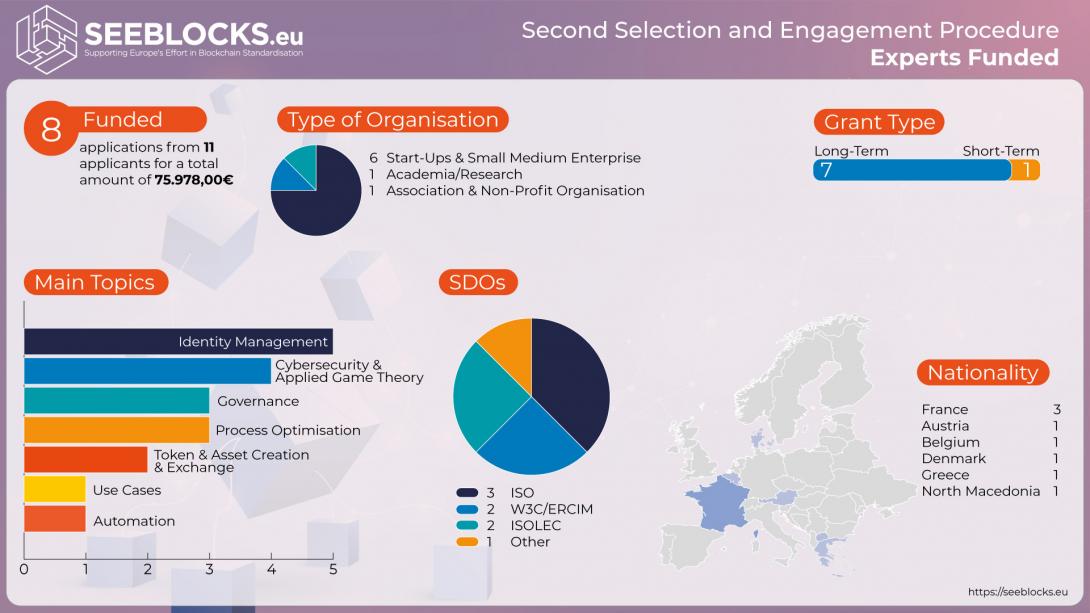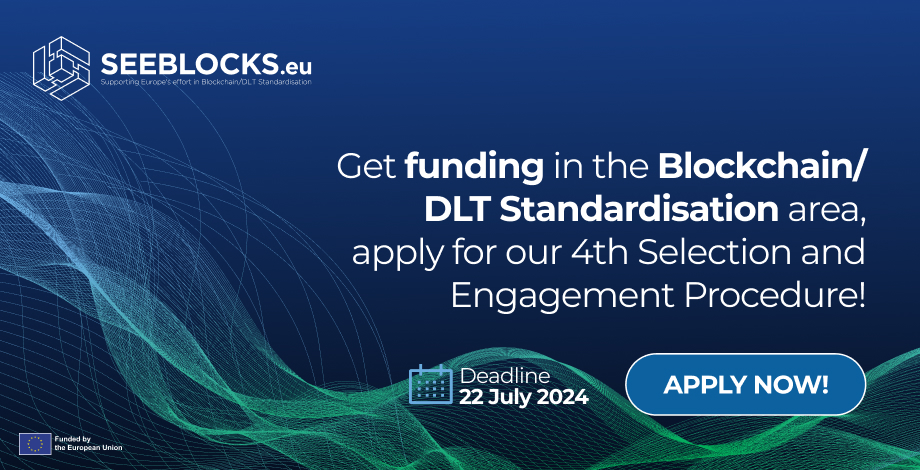Insights from SEEBLOCKS.eu Second Selection and Engagement Procedure for blockchain experts
17 July 2024

Diverse European Expertise Secured
Following on the heels of our first Selection and Engagement Procedure (SEP), SEEBLOCKS announces that our second SEP is now complete. A new group of eight experts selected from eleven applications will be receiving a total of nearly 76 thousand Euros to work on an exciting new set of Blockchain / DLT standardisation activities. Our new group continues to reflect the robust diversity of the European Blockchain / DLT community, with representation from France, Austria, Belgium, Denmark, Greece, and North Macedonia. Topics in identity management remain those most addressed, but cybersecurity has come more strongly into focus in our new set of activities. Read on for a complete overview!
Shifting Focus: Identity Management and Cybersecurity
While it is important that Europe pursue its own standardisation initiatives, it is likewise important to recognise that blockchain/DLT has global impact, and Europe must remain active in global standardisation bodies to ensure that its interests and core values are promoted, especially in key areas such as cybersecurity, privacy, and decentralised identity management. This is exactly what one of our experts is doing, as convenor of ISO/TC 307, the ISO framework for transversal standards.
Driving Sustainability in Blockchain/DLT
Speaking of ISO/TC 307 … another opportunity for this important Technical Committee is to bring clarity to the issue of sustainability of blockchain/DLT technologies. These technologies have gradually acquired the unfortunate reputation of not having a sustainable future. One of our experts is working to address this problem by drafting a new sustainability section for the ISO/TC307 Strategic Business Plan, to help develop new standards with a sustainability focus. With sound standards, it will become possible to draft clear and unambiguous regulation (such as clear energy requirements on the infamous consensus mechanisms that have contributed to the problematic reputation of blockchain/DLT technologies), and ensure that sustainability takes centre stage not only in technological but also in outreach initiatives.
Work underway to align Smart Contract standards with MiCA and Data Act regulations
Another important role of ISO/TC 307 in blockchain/DLT standardisation is to pursue the harmonisation of standards and alignment with regulations. For example, a key contribution of a standard is to present a taxonomy or classification of entities in the domain of interest, which helps to ensure that everybody is speaking the same language. But what if two standards introduce different taxonomies for the same domain? We want to avoid that through harmonisation. One of our experts is working on the harmonisation of two standards in the area of Smart Contracts, to ensure that the concepts, attributes, and depth of detail in their respective classifications are compatible with each other. Furthermore, with the publication of the MiCA (Markets in Crypto Assets) in 2023, our expert is working to ensure that the relevant standards are perfectly aligned with that regulation as well as the Data Act regulation.
Advancing DLT Privacy Capabilities
As important as harmonisation and alignment of blockchain/DLT standards are, the day-to-day work of Technical Committees like ISO/TC 307 involves the writing of the standards themselves, an arduous and time-consuming task. The SEEBLOCKS SEP funding mechanism helps to finance this work of experts who otherwise would not have the means to participate. A typical example is ISO/AWI (Approved Work Item) 24946, entitled “Requirements and guidance for improving, preserving, and assessing the privacy capability of DLT systems.” One of our experts is being funded to continue contributing to the advancement of this Work Item to a mature state, ready for future emission as a document of clear requirements, accompanied by welcome guidance, in the critical area of DLT privacy.
Long-term Support for DPKI
As our regular readers will know, most of our funding has tended to be long-term – generally six months. The nature of standardisation work is such that a certain length of time is needed to achieve the desired objectives. But some tasks can benefit from an even longer contiguous period of time. An example is the work on a Distributed Public Key Infrastructure (DPKI) that was funded in our first SEP. That project is well underway now, and our expert has been funded once again under our second SEP to continue this work, adding important functionality for access control which will permit exciting new applications that exploit the availability of a DPKI. For example, COVID-19 brought out the need for a global system for recognising valid vaccination certificates. In this second SEP, our expert is working on the extension of so-called attribute certificates with the proper access control mechanisms that would (for example) permit local immigration authorities to access vaccination-related information of arriving travellers with confidence – including the needed safeguards on privacy and security.
Paving the Way for Digital Product Passports
One of the most important applications of blockchain/DLT technologies is ensuring secure and trustworthy supply chains. As one example, our SEEBLOCKS.eu technical lead Fiona Delaney is a Co-founder at Origin Chain Networks, whose mission is “forge a future of food we trust” by securing transparent and trustworthy food supply chains. A critical concept in this application space is the so-called Digital Product Passport (DPP), which accompanies a product throughout its lifecycle in the supply chain and provides customers and suppliers alike with trustworthy information about the product. In the case of food, its origins may be critical information; in the case of batteries, their characteristics related to objectives of the circular economy may be important. But the implementation of a universal DPP that can travel easily across supply chains and vendor ecosystems presents major hurdles of interoperability. This is where standards come in, and one of our experts is now working on a project called SECTRACE – secure and interoperable tracing for Digital Product Passports.
Closing Gaps in DID Standardisation
Another core application of blockchain/DLT technologies concerns the decentralisation of many different things that were previously centralised. For example, Decentralised Autonomous Organisations (DAOs) introduce a new form of decentralised governance into organisations. A further example is the concept of Decentralised Identifiers (DIDs). DIDs are a building block of self-sovereign identity, which can not only decouple a person’s identity information from central control (making it effectively portable), but also empower the person to be able to disclose only the information they want to disclose, a crucial European value. The European Self-Sovereign Identity (ESSIF) project is aimed at building next-generation digital identity infrastructure that has European values built-in. However, just like Digital Product Passports, Decentralised Identifiers need standardisation in order to be able to travel freely across ecosystems. One of our experts is working on closing some remaining gaps in DID standardisation. For example, although many companies and projects have created practical implementations of the resolving of DIDs to their DID documents, each has done so in its own way. But resolving DIDs is so fundamental that it is effectively a prerequisite for creating higher-level building blocks: it needs standardisation!
Preparing for the Digital Euro
Most of us with personal bank accounts are familiar by now with the SEPA (Single Euro Payments Area) system, which allows us to send and receive Euros in the European single currency area (e.g., between Italy and Germany). With its Digital Euro project, The European Central Bank (ECB) hopes to complement the Euro with new and innovative forms of payment (for example, in retail contexts) while building trust in digital cash – for example, by maintaining the role of the ECB as a monetary anchor and providing high levels of privacy protection. And of course, we expect everything else to function as before with the Digital Euro; for example, we expect debt collection to work as before, so that creditors can collect their rightfully due payments from debtors. But the SEPA system architecture is fundamentally different from the envisioned Digital Euro architecture, which will be based on DLT technology. That means that, for example, private debt collection procedures cannot remain the same. Procedures such as private execution of debt collection through court orders will be impossible to handle centrally (through the ECB); rather, local decentralised solutions will have to be provided for collection companies, etc. This is just one of the issues that will have to be addressed along the way to a Digital Euro, and one of our experts is working on the development of a voluntary standard that will cover numerous aspects of private debt enforcement in the context of the Digital Euro Project.
The fourth and final Selection and Engagement procedure will close on July 22nd 2024.
